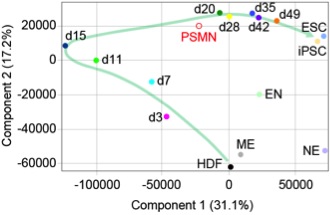
Research Activities
Research Activities
Publications
May 13, 2014
Human somatic cells pass through a primitive streak-like stage during reprogramming - Partial elucidation of the reprogramming mechanism -
A Kyoto University research team led by CiRA lecturer Kazutoshi Takahashi, former CiRA researcher Koji Tanabe and CiRA Professor Shinya Yamanaka has established that, in the process of reprogramming, human somatic cells pass through a state similar to that of primitive-streak cells.
In mammalian embryonic development, it is known that epiblasts pass through a stage characterized by a structure known as the primitive streak, from which they then differentiate into endoderm and mesoderm. iPS cells are somatic cells which have re-acquired pluripotency through exposure to a small number of transcription factors such as OCT3/4, SOX2, KLF4 and c-MYC (OSKM), but the process involved is not yet sufficiently understood. Various methods of generating iPS cells have been reported. When OSKM alone is used, the success rate in generating iPS cells is very low. This seems to indicate either that some block to reprogramming is present, or that some as yet unknown event is necessary to promote efficient reprogramming.
Dr. Takahashi's research team has so far established that there are two stages in the process of reprogramming into iPS cells, and that, although many cells successfully reach the first stage, few cells advance into the subsequent process of maturation into iPS cells.
In the present study, the researchers discovered that, during the latter part of the human cell reprogramming process, cells show strong expression of marker genes for mesendoderm, which is an important constituent element of the primitive streak. Dr. Takahashi and his team also found that a protein named FOXH1, known to be involved in primitive streak formation, promotes human fibroblast reprogramming in the early developmental stage. These findings suggest that cells in the process of human somatic cell reprogramming pass through a transient stage in which they resemble cells at the primitive streak stage, which is a stage along the pathway to differentiation.
The research findings were published in Nature Communications on April 24, 2014 (Japanese Standard Time).

Figure Cells in the reprogramming process resemble primitive streak mesendoderm
A microarray analysis was carried out on cells during the reprogramming process and a plot made showing the position of the different cells according to principal component analysis. It was found that cells developed into iPS cells after passing though an intermediate stage (in the vicinity of d20) closely resembling the primitive streak mesendodermal state.
Paper Details
- Journal: Nature Communications
- Title: Induction of pluripotency in human somatic cells via a transient state resembling primitive streak-like mesendoderm
- Authors: Kazutoshi Takahashi, Koji Tanabe, Mari Ohnuki, Megumi Narita, Aki Sasaki, Masamichi Yamamoto, Michiko Nakamura, Kenta Sutou, Kenji Osafune, and Shinya Yamanaka






















